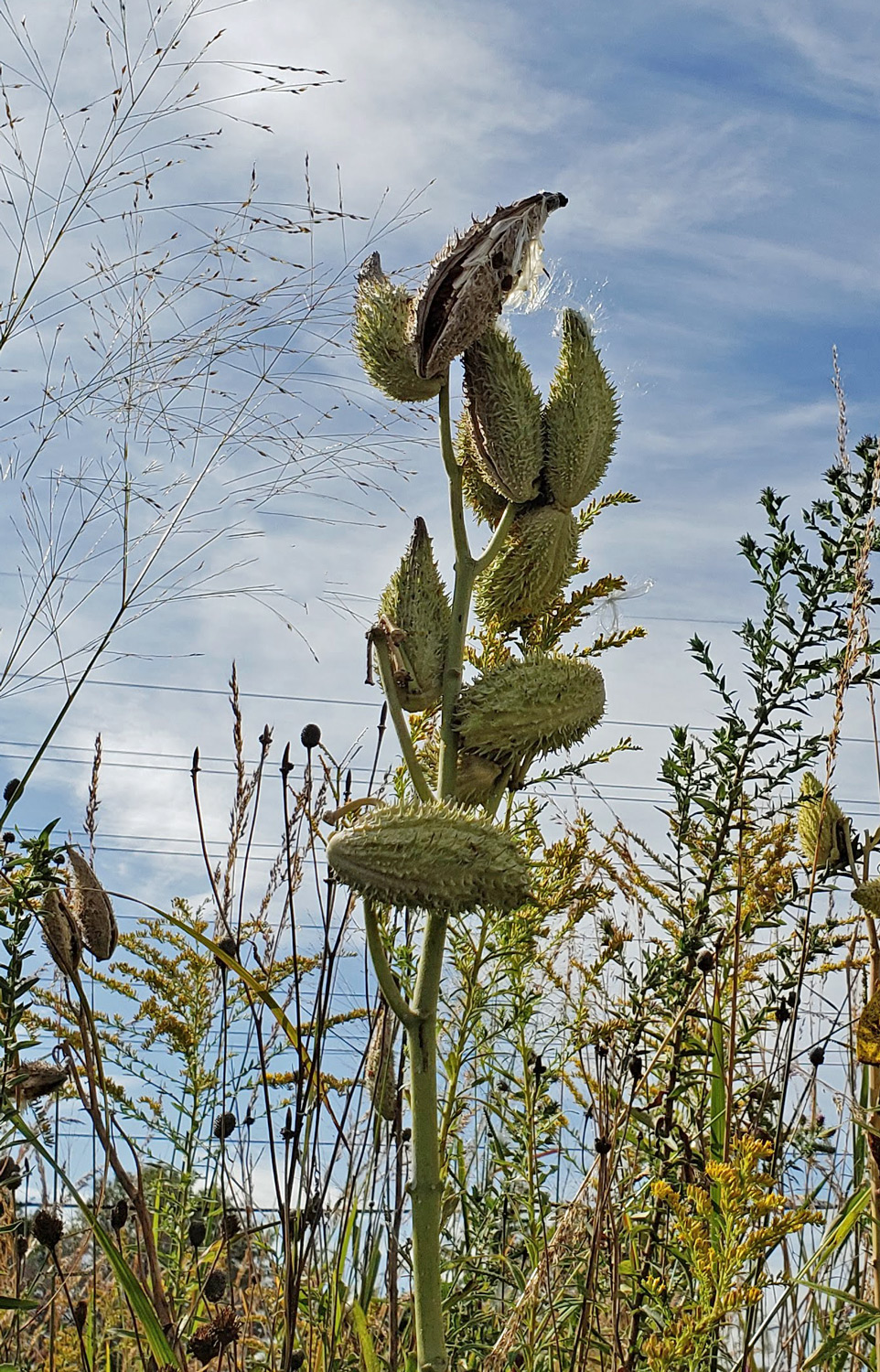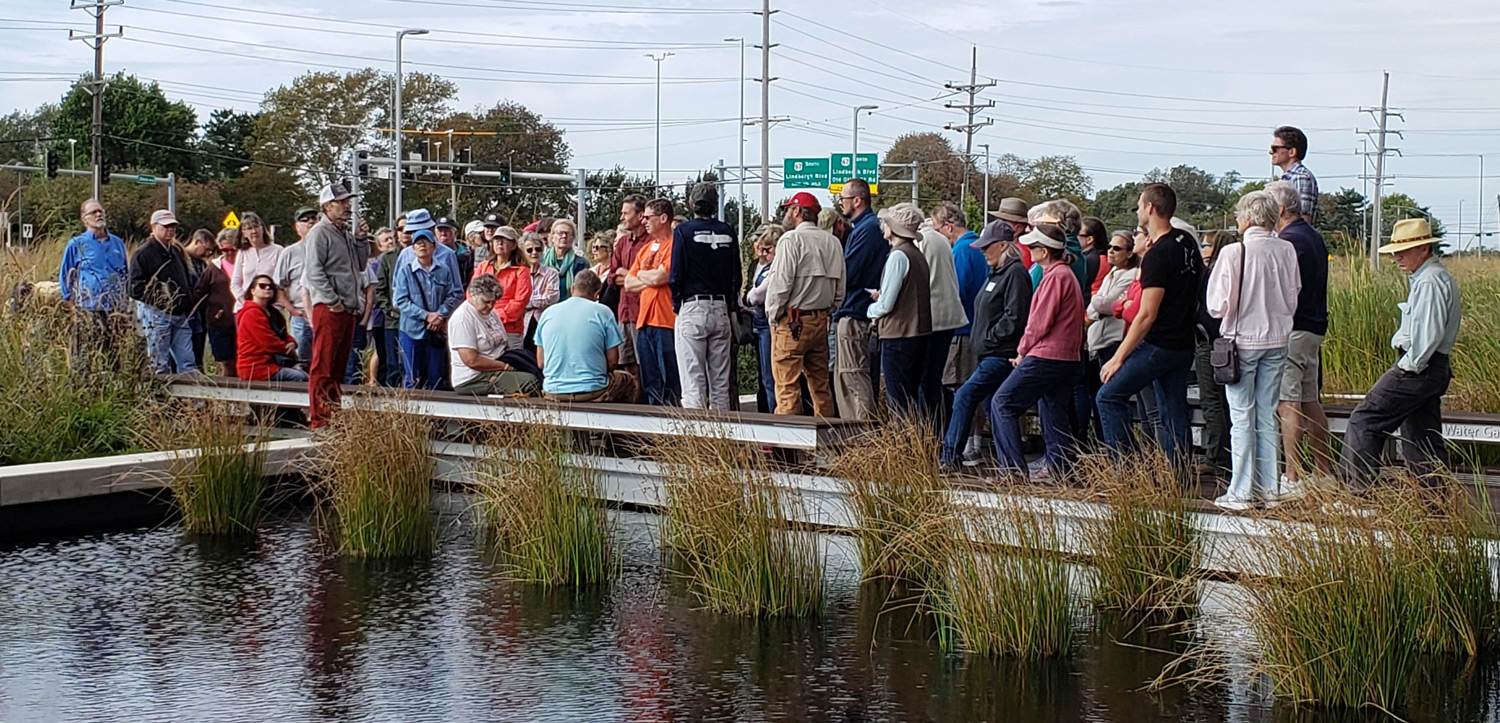Wild Ones Gathering
Danforth Plant Science Center in Creve Coeur, MO
Native Prairie Area
Saturday, 5 October 2019
Attendance: 47 Members 21 Guests
After a brief welcome from Marsha, our president, she introduced Scott Woodbury, the planner, designer and foremost horticulturalist on native plants of the Midwest. The grounds of the Danforth Plant Science Center were sown in early 2016 with over 70 species of grasses and forbs. The custom seed mix was developed from several sources, including Hamilton Native Outpost, Missouri Wildflowers Nursery and Shaw Nature Reserve.
Because of all the plant research being conducted in the Danforth Center buildings, the leadership decided that they wanted a tall-grass prairie, just like Henry Shaw saw when he first arrived in St. Louis in 1819. The land that he rode his horse out to see, became what we know as the Missouri Botanical Garden today.
 Overcoming the negative perceptions by the neighbors and drive-by observer critics in cars, the landscape in front of the Danforth buildings evolved into the beautiful sea of grasses and forbs with thriving wildlife, birds and insects! Fortunately, the leadership persevered through the ‘growing years’ to see their dream and vision come true: a sustainable area where water and resource conserving plays out with living native plants. Also, more plant diversity means more living diversity!
Overcoming the negative perceptions by the neighbors and drive-by observer critics in cars, the landscape in front of the Danforth buildings evolved into the beautiful sea of grasses and forbs with thriving wildlife, birds and insects! Fortunately, the leadership persevered through the ‘growing years’ to see their dream and vision come true: a sustainable area where water and resource conserving plays out with living native plants. Also, more plant diversity means more living diversity!
The initial cost of planting was significant, but the bonus comes in decreased maintenance costs. According to Scott, the cost of maintenance is $2 per square foot vs $12 for a typical landscape. Native Landscape Solutions maintains the prairie now. Important features added to the area were borders, hardscape walls and walking paths within the grasses. These edges add to the aesthetics and easier maintenance.
As we walked around the property, Scott reminded us how we came to have non-sustainable landscapes with turf grass, Bradford pears and burning bushes. It all started with tradition, low cost plants and their accessibility, and homeowner requests.
Many questions were asked along the walk, including comparing the root system of native grasses to turf grass. The difference is astounding; from the one-inch turf grass roots to the eight-foot roots of big bluestem grass and the Indian grass. Just Google it and you’ll be amazed! (click here for root systems of prairie plants illustration)
Scott also talked about adding mycorrhizae to the soil. The fungus forms a beneficial relationship at the plant root tips. It creates a network that increases the plant’s capacity to absorb more water and nutrients with the resultant rapid development of roots of the plants. MycoBloom, located in Kansas City, is the company that provided the locally appropriate mycorrhizae for the seeding of the Danforth prairie.
Another interesting comment noted how ‘quiet’ this landscape was as compared to ones where lawnmowers and weed-whackers are being used. Very true and another great selling point for native areas!
While it was past the prime blooming time for many of the forbs, the little bluestem was radiant in it’s red stems with white seed tufts.
Here are some of the forbs and grasses planted in this area:
Several species of milkweed (Asclepias spp.)
White wild indigo (Baptisia alba)
Blue false indigo (Baptisia australis)
Purple prairie clover (Dalea purpura)
Prairie blazing star (Liatris pycnostachya)
Wild bergamot (Monarda fistulosa)
Obedient plant (Physostegia virginiana)
Black-eyed Susan (Rudbeckia hirta)
Blue Sage (Salvia azurea)
New England Aster (Symphyotrichum novae-angliae)
Big bluestem (Andropogon gererdii)
Sideoats grama (Bouteloua curtipendula)
Little bluestem (Schizachyrium scoparium)
Indian grass (Sorghastrum nutans)
A big shout out of thanks to our Programming Committee for scheduling the Danforth Center Prairie area as our last out-door gathering of the year. It was spectacular! And please know that the public is welcome to walk around the prairie at any time.
Submitted by Ginny Johnson, Secretary




